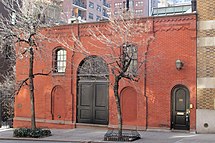Sniffen Court Historic District
Sniffen Court Historic District | |
 (2012) | |
| Location | off East 36th Street between Third and Lexington Avenues Manhattan, New York City |
|---|---|
| Coordinates | 40°44′49″N 73°58′41″W / 40.74694°N 73.97806°W |
| Built | 1863-1864 |
| Built by | John Sniffen |
| Architectural style | Early Romanesque revial |
| NRHP reference No. | 73001224 |
| Significant dates | |
| Added to NRHP | November 28, 1973 |
| Designated NYCL | June 21, 1966 |
The Sniffen Court Historic District is one of New York City's smallest historic districts,[1] created on June 21, 1966, by the New York City Landmarks Preservation Commission.[2] Sniffen Court, named after John Sniffen, a local builder,[2] is a small close-ended mews that runs perpendicularly southwest off of East 36th Street between Third and Lexington Avenues in the Murray Hill neighborhood of Manhattan. The district encompasses the entire alley, which consists of 10 two-story brick stables built in 1863-1864 in the early Romanesque Revival style.[1][3]
As the need for carriage houses lessened, the buildings were converted for other uses.[2] In 1918, two of the stables (#1, also known as 150 East 36th Street, and #3) were bought by the Amateur Comedy Club, which has been in existence since 1884, to be their clubhouse and theatre; they remain that today.[4] In the 1920s, the process of conversion continued,[1] and by 1966 one of the buildings was in use as an architect's office, the gabled building at #2 (156 East 36th Street) was the home of a noted architect, while the remainder were small private residences.[2]
Two artists associated with the mews were the sculptors Malvina Hoffman and Harriet Whitney Frishmuth, both of whom had studios in the Court.[1][5] On the rear of the alley are mounted two sculpted plaques of Greek horseman by Hoffman.[2]
On November 28, 1973, the Historic District was added to the National Register of Historic Places.
In popular culture
- Sniffen Court is the location used for the cover of the Strange Days album by The Doors, released in 1967.[6]
Gallery
-
1 Sniffen Court is also 150 East 36th Street
-
The buildings on the east side of the mews
-
Sculpted plaques by Malvina Hoffman
See also
- List of New York City Landmarks
- National Register of Historic Places listings in New York County, New York
References
- ^ a b c d New York City Landmarks Preservation Commission; Dolkart, Andrew S.; Postal, Matthew A. (2009). Postal, Matthew A. (ed.). Guide to New York City Landmarks (4th ed.). New York: John Wiley & Sons. ISBN 978-0-470-28963-1. p.106
- ^ a b c d e New York City Landmarks Preservation Commission, "Sniffen Court Designation Report" (June 21, 1966)
- ^ White, Norval; Willensky, Elliot; Leadon, Fran (2010). AIA Guide to New York City (5th ed.). New York: Oxford University Press. ISBN 978-0-19538-386-7., p.284
- ^ Amateur Comedy Club brochure
- ^ "Harriet Frismuth" on the Fine Old Art website
- ^ "Classic Album covers : Strange Days – The Doors". Nevermindthebuspass.com. 2012-02-02. Retrieved 2012-08-15.
External links
 Media related to Sniffen Court Historic District at Wikimedia Commons
Media related to Sniffen Court Historic District at Wikimedia Commons
- Carriage houses in the United States
- Romanesque Revival architecture in New York
- Houses completed in 1864
- Houses on the National Register of Historic Places in Manhattan
- Murray Hill, Manhattan
- Historic districts in Manhattan
- Historic districts on the National Register of Historic Places in Manhattan
- Carriage houses on the National Register of Historic Places
- Transportation buildings and structures on the National Register of Historic Places in New York






